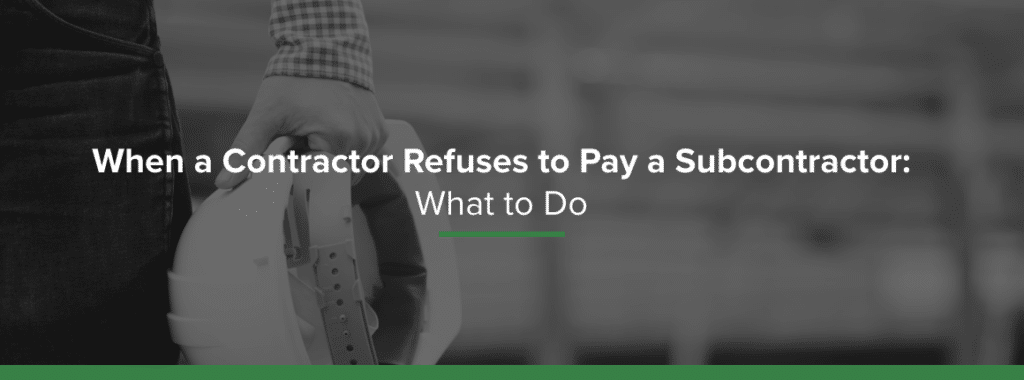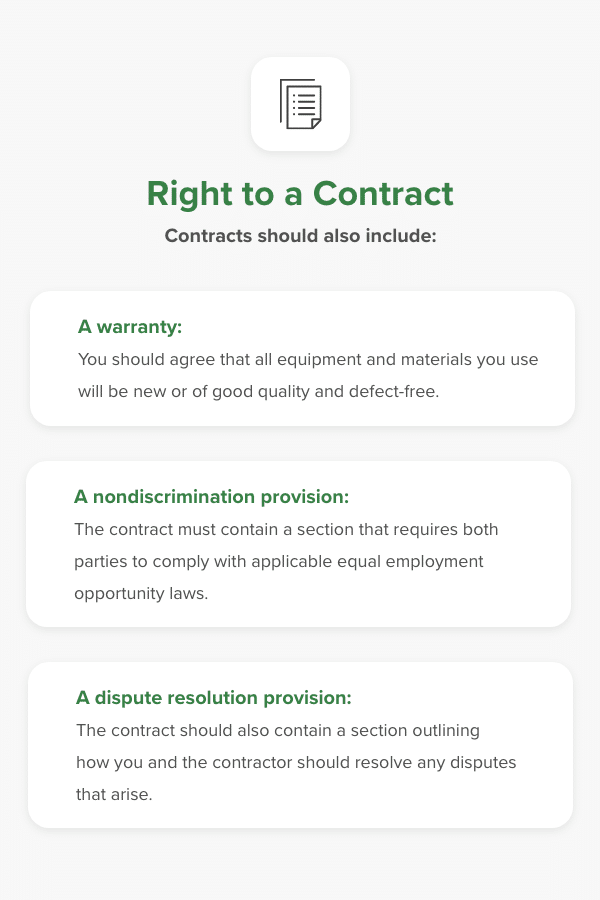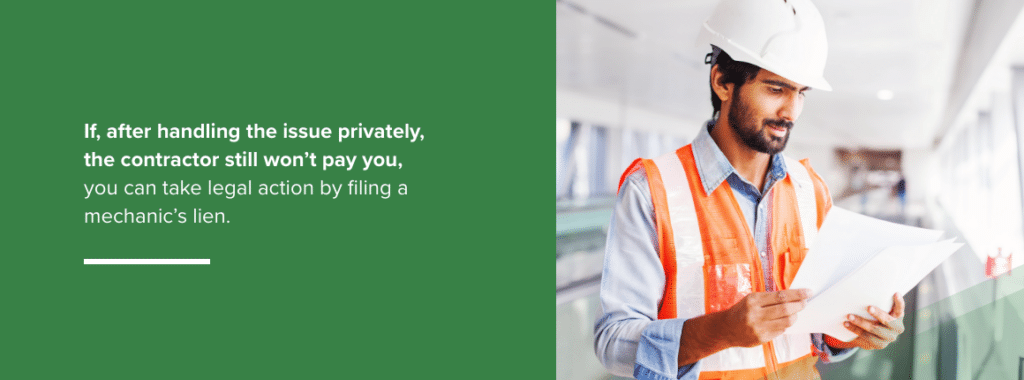
Contracted workers enter work agreements expecting to get paid for their labor and time. If you’re not paid by a contractor for your work as a subcontractor, you can take several steps to verify your rights and request payment.
Contract laws vary by state, and federal contractors also have their own laws to follow, so contractors and subcontractors should learn their rights in the specific areas they work in. This guide provides a general idea of how to navigate payment contracts between contractors and subcontractors, including what to do if a contractor does not pay you.
Knowing Your Rights as a Subcontractor
As a subcontractor, your first step to ensuring you receive your payment is knowing your rights before taking on a job. You should familiarize yourself with the contract laws in your area and verify that all your proceedings with a contractor comply with these laws.
It’s best to stay organized and updated on any changes to contract laws, so you can easily review proposed contracts and only agree to jobs that will uphold your working and payment rights. If a contractor wrongfully refuses to pay you, you have specific rights you can claim.

Right to a Contract
Contracts are one of your most important tools. All subcontractors have the right to a contract that outlines expectations for every aspect of their job. Contracts include agreed-upon rules for the contractor-subcontractor relationship that protect you from being taken advantage of.
Every subcontract job should include a contract document covering all the terms of work and payment. The contract should clearly state what you need to do to get paid and how and when you’ll get paid, so you always know how to receive what you’re owed. In writing, the contract should state that it’s mutually binding, meaning both you and the contractor should agree to its terms.
Contracts should also include:
- A warranty: You should agree that all equipment and materials you use will be new or of good quality and defect-free.
- A nondiscrimination provision: The contract must contain a section that requires both parties to comply with applicable equal employment opportunity laws.
- A dispute resolution provision: The contract should also contain a section outlining how you and the contractor should resolve any disputes that arise.
Whenever you receive a contract for a job, you should read it thoroughly to understand what it states and ensure it covers all the necessary terms to help you perform your job as expected and receive your payment.
Right to Receive Payment
When reading over a contract, you should ensure the document clearly states how much you’ll be compensated, as well as how and when you’ll receive this compensation. The contract should include this information in a clearly marked section and should comply with laws that state you should receive your payment within 10 days of the contractor being paid.
Contracts protect subcontractors from unfair payment situations by providing a written agreement. The contractor provides the terms of payment, and as long as you follow these terms, the contractor is legally obligated to pay you as you initially agreed.
Contracts should also be free from terms or conditions meant to prohibit you from exercising your rights to request payment through legal action if the contractor doesn’t pay you according to your contract.
When Contractors Can Legally Withhold Payment
Usually, general contractors are in charge of coordinating subcontractors and supervising their work. Within these duties, contractors are responsible for paying subcontractors for their work.
A typical subcontractor payment process begins with you giving the contractor your payment request within enough time for the contractor to include it in their own payment request. The contractor submits this combined payment request to the owner of the property they’re working on.
After receiving their own payment from the property owner, the contractor has 10 days to pay you the amount you’re owed. Often, subcontractors may not get paid until long after the 10 days are up, either for valid legal reasons, accidental disorganization or genuine contractor negligence.
In some cases, contractors can hold off on paying a subcontractor based on specific legal discrepancies. A contractor is legally allowed to refuse payment to you if:
- You have violated the terms of the initial contract you and the contractor had agreed upon.
- You have not performed your job to the standards both parties agreed upon.
- The contractor must resolve disputed claims involving your work.
As a subcontractor, you can pursue legal action against your contractors for illegally withholding payment. However, you should also take certain actions within your work to avoid payment issues, including:
- Knowing about and complying with your contract’s terms.
- Doing work to the best of your ability and to the standards of your contract.
When subcontractors complete the work they’ve agreed to do and uphold the details of their specific contracts, they’re less likely to experience legal opposition to payment.

What Is a Mechanic’s Lien?
A mechanic’s lien is a document that guarantees payment to subcontractors. Liens ensure workers are compensated if for some reason they’re not paid by contractors as promised. When you file a mechanic’s lien, it can ensure you’re paid either by the contractor, property owner, or another involved party.
Each state has its own laws and timelines for when you can file mechanic’s liens. A mechanic’s lien sets a firm payment deadline that responsible parties must adhere to, giving you a better guarantee of getting paid.
The Property Owner’s Role in Mechanic’s Liens
Filing a lien gets the attention of parties other than the general contractor. Liens put property owners at risk of having to pay the subcontractor themselves, even though they most likely already paid the contractor in full – including a portion for the subcontractor’s work.
When you file a lien, it gets filed with land records for the property you worked on and comes up in title searches for that property. This process helps ensure the property isn’t sold or refinanced without the lien being paid or otherwise addressed. A lien essentially places the property up as collateral if you don’t get paid by the deadline as another way to safeguard your payments.
Property owners don’t want to be in this position, so filing a lien can help alert them to the contractor’s lack of payment. From there, they can seek reimbursement from the contractor if they decide to pay your expenses themselves to release their property from the lien. Getting more people involved increases your chances of being paid by someone, even if it’s not the initial contractor.
However, when you file a notice of lien, many states give property owners the option to protect themselves through a lien waiver process. The lien waiver proves the owner already paid your bill to the contractor and transfers the payment responsibility to another party, such as the contractor.
How to File a Mechanic’s Lien
Different states have different laws regarding the exact eligibility timelines for subcontractor liens. Since a lien is meant to help protect your rights throughout the contract, some steps of the filing process happen at the beginning of the project, before any missed payments occur. In general, the process for filing a lien is:
- Submitting proof of commencement: Before the contracted work begins, the property owner should file a notice of commencement, which is a compilation of all project information you can use in the future to assert your lien rights. You can request a copy of this notice from the owners for your records.
- Submitting proof of furnishing: For a set amount of time after beginning a project, you can preserve your lien rights by filing a notice of furnishing. This notice is proof that you fulfilled your contract.
- Filing the lien: If you have not been paid by the terms of your contract, and the above documentation has been submitted, you can file a mechanic’s lien. You must file the lien within a certain number of days after the last day of work performed for the job, depending on the type of work performed. This affidavit details the dates of the project, your duties and the amount of money you are owed.
Subcontractors who win their lien case will receive the amount of money the lien is for. If the lien becomes a lawsuit, the winning party sometimes receives the costs of the suit and its attorney’s fees.

The Importance of Organized Documentation
Collecting documentation is one of the most effective ways for you to stay up-to-date with your responsibilities. It’s also an important process for you to follow in case a contract dispute drives you to take legal action to receive payment.
From the moment you agree to a job to the moment you finish your contractual obligations, you should record all your actions and correspondences and keep those records organized and accessible. Collect all your contracts and invoices and organize them by job. You should also document all the work you perform each day, writing detailed records of what tools and materials you use, as well as what you accomplish.
Proper, organized documentation helps all jobs go smoothly and gives you substantial evidence if you ever need to dispute an unfulfilled payment. When you file a mechanic’s lien, you need to fill out detailed paperwork with exact dates, addresses and descriptions of the work you performed. Staying organized from the beginning helps you assert your payment rights.
Trying to Resolve the Issue Yourself
If a contractor doesn’t pay you within the agreed-upon time frame, you should first address this issue with the contractor. Taking the issue to court is a costly and time-consuming endeavor that may not be necessary. The contractor could have one of several reasons for delaying your payment, and a civil conversation may easily resolve the issue.
Even formal business proceedings are susceptible to human error. General contractors usually juggle a lot of different people and paperwork, meaning some payments may slip through the cracks. The contractor could have accidentally lost your invoice or mistakenly checked that item off their to-do list. Additionally, the more jobs a contractor books, the more responsibilities they have, and the easier it is to get behind on bills they fully intend to pay.
If you haven’t been paid, remind contractors of their contractual obligation for payment, showing them relevant records if necessary. The contractor can then explain their reasoning for not fulfilling the invoice.
Resolving an issue peacefully and directly often helps maintain contractor-subcontractor relationships, so both parties can continue to benefit from each other’s work in the future.
Taking Legal Action
If, after handling the issue privately, the contractor still won’t pay you, you can take legal action by filing a mechanic’s lien. In Ohio, for example, subcontractors can file a civil action to recover their payment beginning 30 days after the payment is due. If you choose to take legal action, you should understand your local laws regarding this process, its requirements and its deadlines.
Taking the issue to court should be the last effort you take after making every other available effort to receive your payment. Court proceedings can be lengthy and costly, but they can also give you the power you need to protect your rights and collect payment for your work.
Benefitting From an Attorney
During the mechanic’s lien process, you may find it helpful to hire an attorney to help you navigate the legal proceedings. An attorney can help you understand the nuances of lien laws and subcontractor payment rights in your specific state and assist you in organizing your records for a compelling case.
Receiving an attorney’s guidance can also help you continue to dedicate most of your time to other projects. Even as you wait on your job’s payment, you should still be able to take advantage of all other work opportunities you get. Using an attorney in the lien process helps you assert your rights without hindering your overall career.

Streamline Collaboration With STACK
Successful construction projects start with an organized preconstruction process. Whether you’re a general contractor or a subcontractor, you can improve your business relationships with other workers through a streamlined, all-in-one platform. With the right tools at your fingertips, such as construction software for subcontractors, you can make better bid decisions and choose projects with contractors you trust.
Avoid entering risky projects or underestimating costs with STACK, a cloud-based software program. STACK’s intuitive general contractor software lets you sort documents, organize digital blueprints and save time and money with accurate measuring tools and convenient templates. From creating bills of materials to calculating project estimates, our solutions give you more control over the entire preconstruction process. You can even invite other teams to collaborate so everyone stays updated on the latest installments.
Schedule a free demo today to test our software and see how our preconstruction platform can take your business to the next level!








